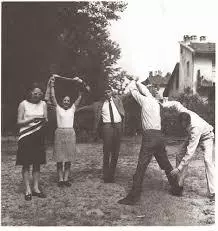The group: Carla Accardi, Ugo Attardi, Pietro Consagra, Piero Dorazio, Mino Guerrini, Achille Perilli, Antonio Sanfilippo and Giulio Turcato, they were called together as "Grouppo Forma 1", and proclaimed themselves "formalists and Marxists, believe that the terms Marxism and formalism are not irreconcilable ..." supporters of an art structured but not realistic, that gives importance to the form and sign in their basic essential meaning, stating, for example, "we are interested in the form of lemon, not in the lemon" in their works by eliminating any pretense symbolist or psychological attitude. The publication of the manifesto comes at a time when the differences are strong on aesthetic choices between supporters of abstract and figurative art proponents of civil commitment.
Guttuso (1912/1985), that during the period of fascism has been a point of reference for young artists, is in favor of a neo-realist painting allined woth the positions of the Italian Communist Party. The General Secretary of the P.C.I. Palmiro Togliatti enters personally in the dispute: condemn in no uncertain terms the abstract and is in favor of social realism.
The first sentence of the manifesto, "We proclaim formalists and Marxists, believe that the terms Marxism and formalism are not anreconcilable (...)", it means the attempt to reconcile the views of the political group with the choice of abstraction. Membership in the abstract language will remain in the work of Carla Accardi, Pietro Consagra, Piero Dorazio, Achille Perilli, Antonio Sanfilippo, and Giulio Turcato. Ugo Attardi already in '51 back to figurative painting while Mino Guerrini leaves to devote himself to journalism and film industry. The choice of abstraction, the relations of friendship and cooperation between the artists and the frequent joint initiatives, have led to summarize their activities in the late '40s and the' 50s under the name of Group Forma 1 or Forma.
Forma 1 proposed a mediation between the two opposite languages of Italian art of the period, divided between abstraction and realism, with an art based on the insights of the artist represented in an objective way, which become concrete images of form and color, outside of any formal abstraction.
As time goes on, every artist's group developed a personal language, some went back from abstract to figurative, while the abstract discourse will be carried out mainly by Carla Accardi, researcher and experimenter like this, according to a personal poetic related to sign-color with digressions of matter and informal research still not ended. The group ended in 1951, but marked the contemporary Italian art of the twentieth century.
The abstractism in Italy, up to the actually day, remained closed in its niche of fans and artists, instead of in the previous work of artists such as Manlio Rho, Radice Mario, Aldo Galli, Carla Badillo and Carla Prina letting the world would create such artists as Pollock, Riopelle and Dubuffet.
This is not a matter of evolution or artistic choices, but only and exclusively an Italian condition , based in managing the power with socio-political communication. In fact, the abstract and politically had as a starting point the Marxism, created the philosophical conditions that could lead to anarchy, if not over the anarchy itself.
A that time, the two major post World War II Italian Parties, as usual in Italy, use the standard Catholic communication path, decide to enforce the role of figurative art insted of Abstractism, since figurative can format the image, the thoughts and the words how power desire.
The only artist who remained loyal to the manifesto was Carla Accardi, who died in 2014. With her died the last bastion of real genuine Italian abstractionism.
I go around exhibitions and art fairs, and figurative art continue to be predominate, as if to arrogantly ignore that the abstract can and should be a primary form of art form Italy. Many young abstract Italian artists, trying to follow in the footsteps of what was then the abstractism capitalist of the United States, but in general, like I try to do as an artist, the work should start over where it was left by the group Forma 1.
MANIFESTO FORMA 1 – 1947
Carla Accardi, Ugo Attardi, Pietro Consagra, Piero Dorazio, Mino Guerrini, Achille Perilli, Antonio Sanfilippo and Giulio Turcato signed the manifesto "Forma 1 "setting out the following main concepts:
1. In art there is only traditional reality and inventiveness of the pure form;
2. We recognize the formalism the only means to escape decadent influences, psychological, expressionistic;
3. The painting, sculpture, presented as means of expression: the color, the design, the plastic masses, and as fine a harmony of pure forms;
4. The shape is the middle and end; the framework must also serve as a decorative complement of a bare wall, the sculpture as a room's decor; the end of the work of art is the utility, the harmonious beauty, not the heaviness;
5. In our work we use the forms of objective reality as means to achieve abstract shapes objective, we are interested in the shape of lemon, and lemon;
Together with the underwriters of the Manifesto "Forma 1" challenged the use of art in psychologism and sentimentalism, the use of false emotion and to find instrumental etc.
www.antoninolavela.it
 Share / Save
Share / Save






Comments 0
Say something